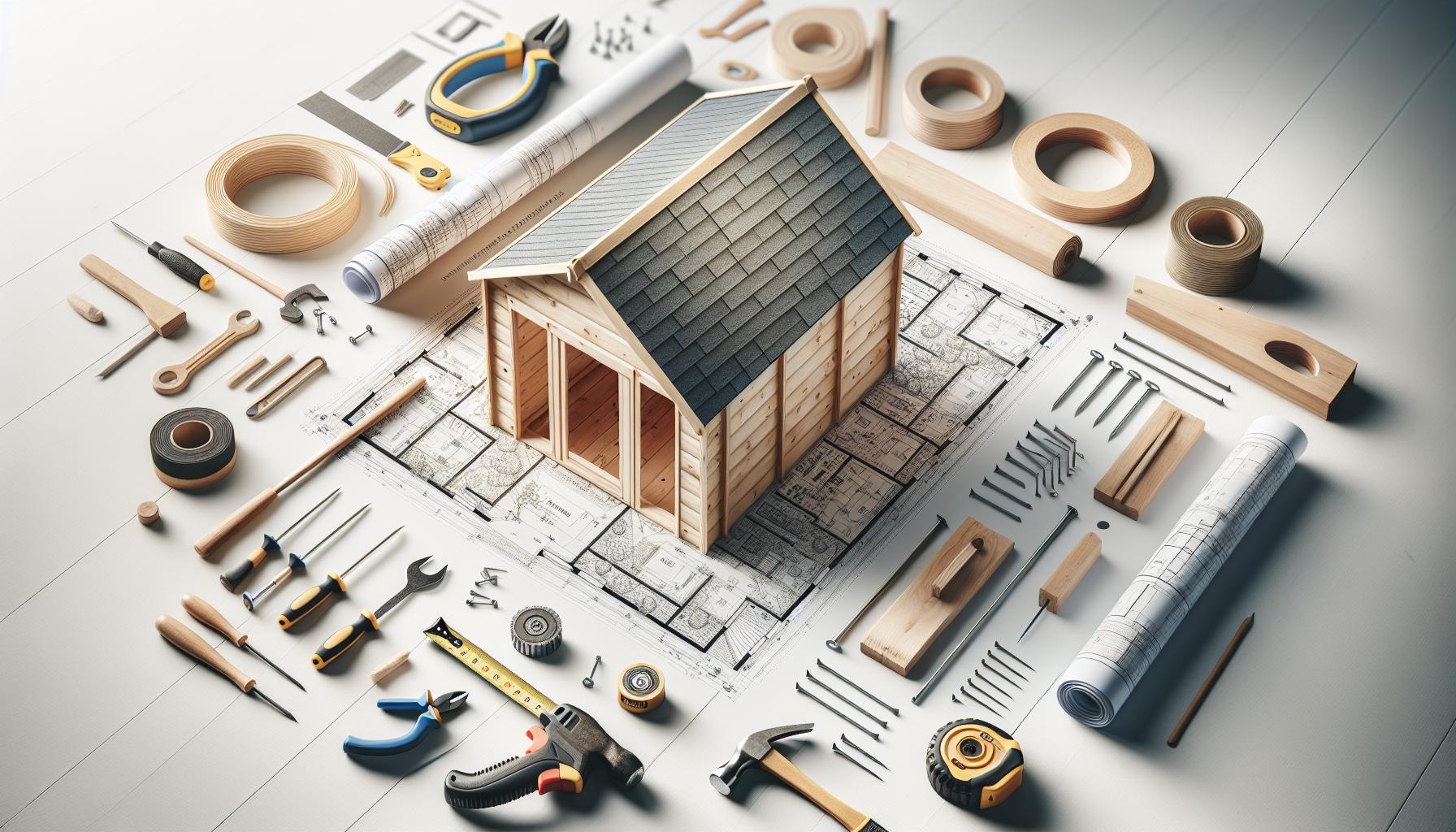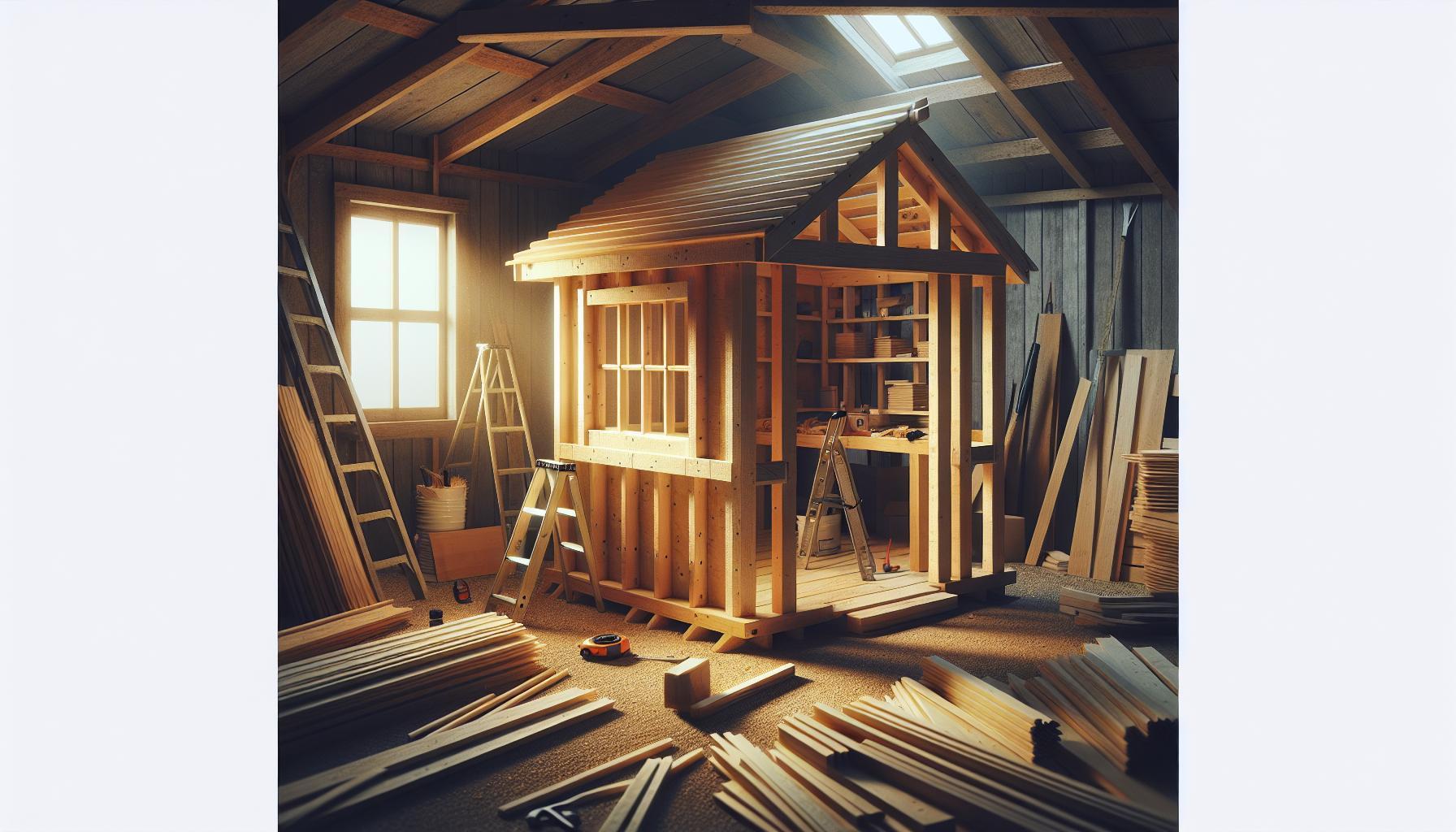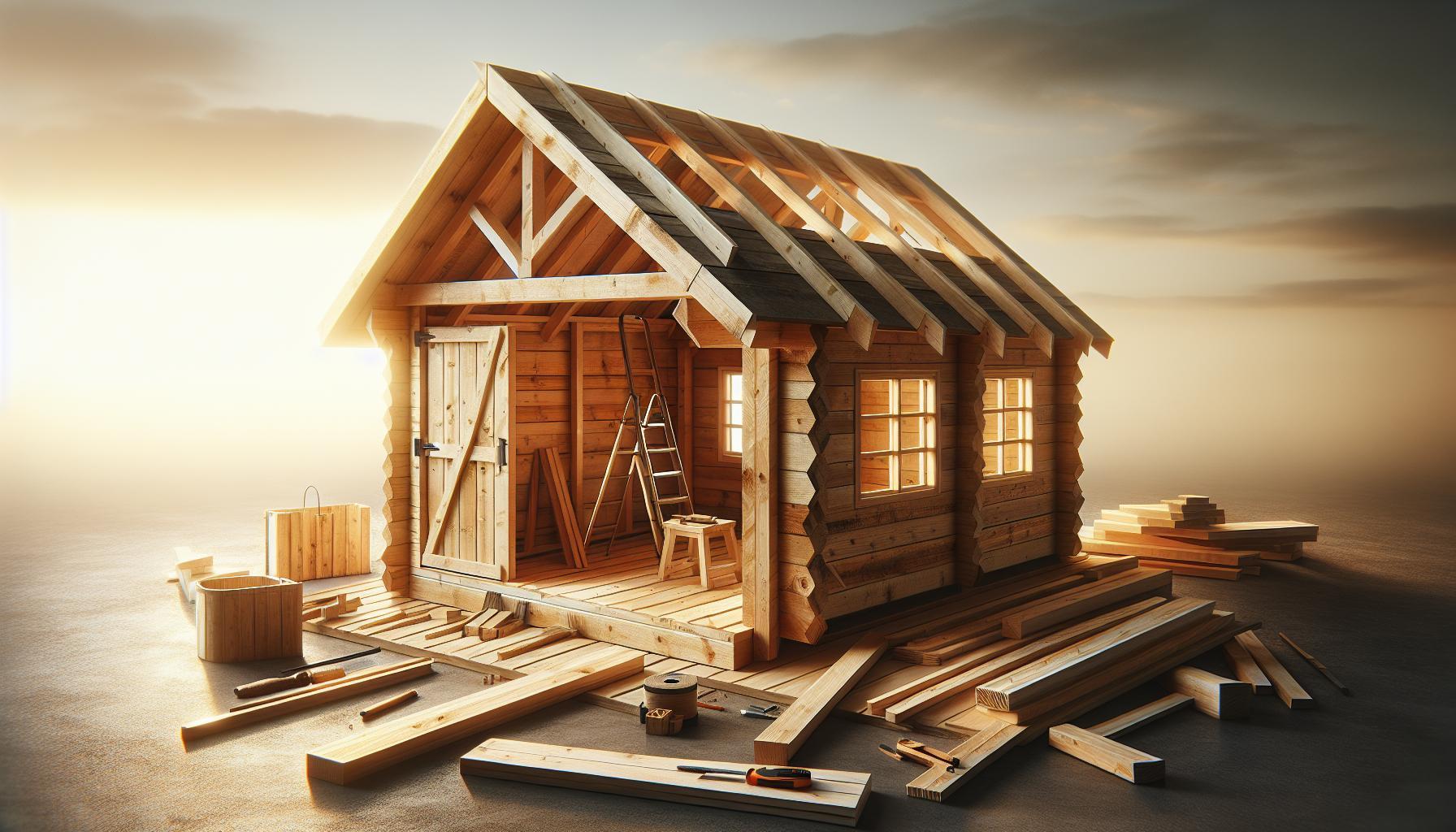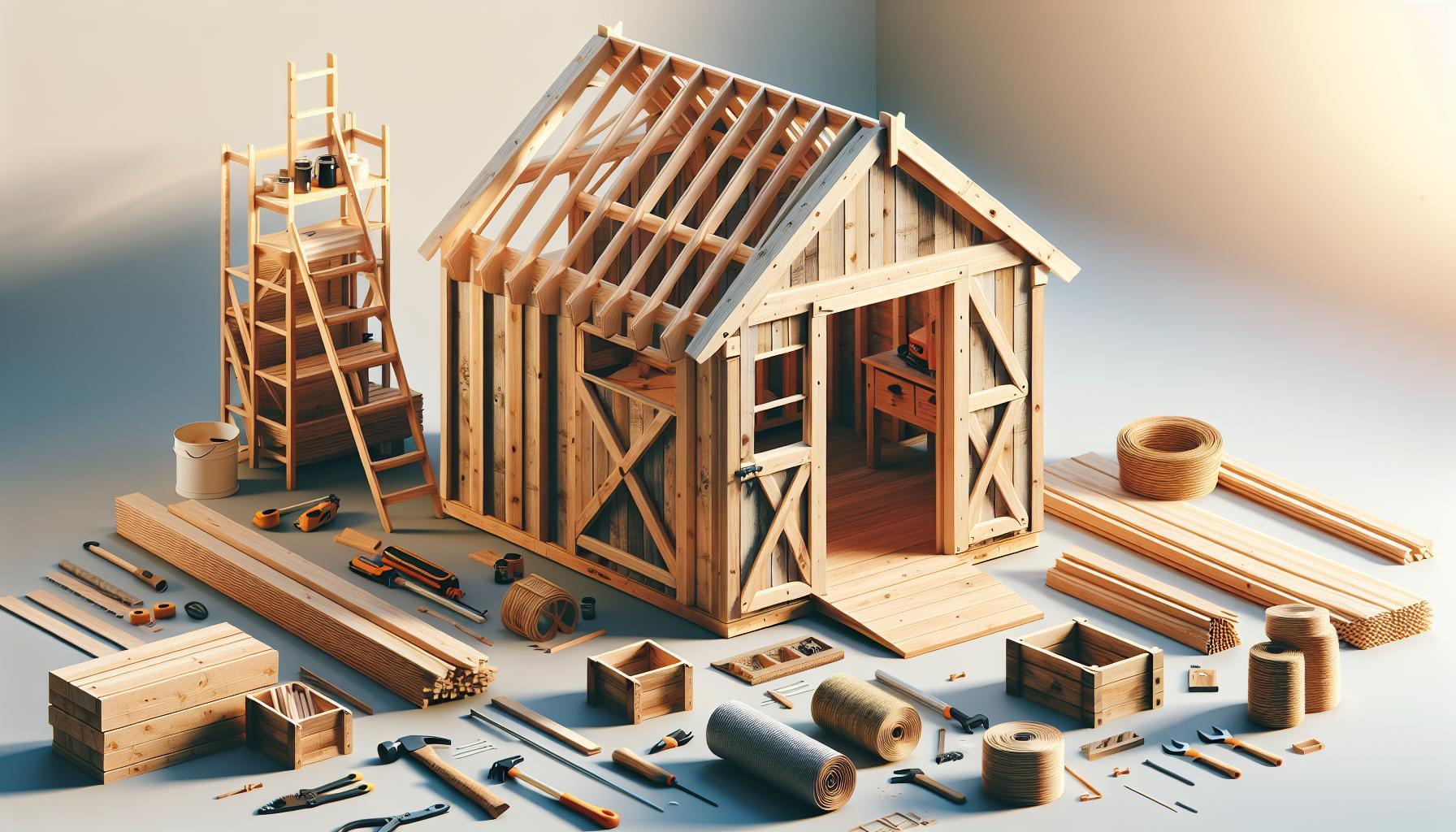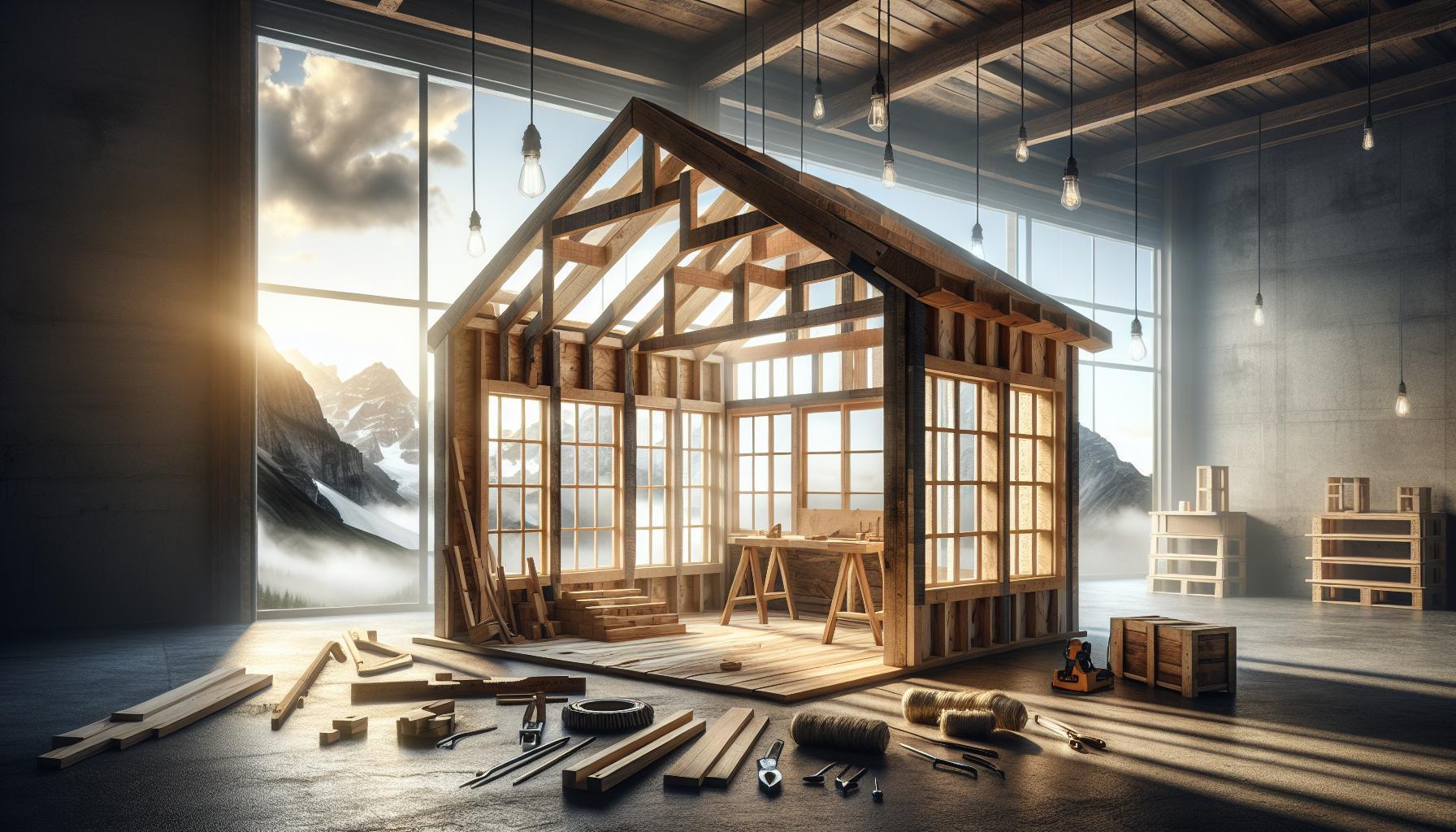building a shed can seem daunting,especially for beginners unsure where to start. However, with the right guidance and a clear step-by-step approach, you can create a functional and stylish space for storage or hobbies. This thorough guide empowers DIY enthusiasts to tackle shed construction confidently,ensuring your project turns into a rewarding success.
Understanding Your Shed: Choosing the Right Design and Size
Choosing the right design and size for your shed is a pivotal step in ensuring it meets your needs while enhancing the aesthetic of your property. With a plethora of styles available such as gable, barn, and lean-to, each option can serve a unique purpose. consideration of your available space and intended use will help you make informed decisions that pay off in functionality and style.
Assessing Your Needs
Before diving into the design process, it’s crucial to assess your storage needs. Ask yourself what you’ll be storing in the shed. Will it be gardening tools, outdoor furniture, or sports equipment? This evaluation will help you determine not just the size but also the layout of your shed. Here are some factors to consider:
- Purpose: Decide whether it will serve solely as storage or if you plan to use it as a workshop.
- Space: Measure your available space to ensure the shed will comfortably fit without overcrowding your yard.
- Accessibility: Think about how frequently you will access the shed and plan for entryways that allow easy access.
Choosing the Right size
The dimensions of your shed should align with your storage requirements and local building regulations. most municipalities allow for a certain size before requiring permits. For instance,in many areas,you can build a shed up to 150 square feet without a permit.
For those new to construction, the following table summarizes common shed sizes and their potential uses:
| Size (sq ft) | Common Uses |
|---|---|
| 50-70 | Small tool storage, gardening supplies |
| 80-100 | Outdoor equipment, bikes, small workshop |
| 120-150 | Extensive storage, larger workshop or studio |
Design Considerations
The design of your shed should not only reflect your personal style but also be functional. Consider features such as windows for natural light, shelving for organized storage, and pest-resistant materials. Research diffrent designs through resources such as family handyman articles that provide step-by-step instructions. incorporating features that allow for future expansion can also be worthwhile as your needs evolve over time.
By considering these aspects when choosing the design and size of your shed, you’ll ensure it is a valuable addition to your property, helping you maximize space and organize your belongings effectively. For further guidance, exploring detailed plans can help you visualize and execute your vision accurately.
Essential Tools and Materials for Your DIY Shed Project
Building a shed can be an immensely rewarding project that not only enhances your outdoor space but also provides practical storage for your tools and equipment. To embark on this DIY venture effectively, it is indeed essential to equip yourself with the right tools and materials. Knowing what you need can make the process smoother and help you achieve the best results.
Necessary Tools for Construction
First and foremost, having the right tools at your disposal is crucial. Here are some of the essential items to consider:
- Hammer: A reliable hammer is vital for driving nails and assembling your shed.
- Saw: Whether you choose a hand saw or a power saw, cutting lumber to size is a major part of shed construction.
- Drill: This tool is indispensable for making holes and driving screws.
- Screwdriver: A set of screwdrivers will ensure you can tighten and secure bolts and screws.
- Level: Achieving a level structure is essential; a level will help you modify the foundation and ensure straight lines.
- Tape Measure: Precise measurements are key to any building project, so a tape measure is a must-have.
- Square: To ensure your angles are correct and your walls are square, a carpenter’s square is indispensable.
Choosing the Right Materials
Once you have your tools, it’s time to gather your materials. The choice of materials can affect both the durability and aesthetic appeal of your shed.Here’s a brief overview of what you might need:
| Material | Description |
|---|---|
| treated Lumber | Ideal for the foundation and sill plate,as it resists rot and decay. |
| Studs (Douglas Fir) | Used for framing the walls, providing strength and stability. |
| Fir Lumber | Commonly used for ceiling joists due to its sturdiness. |
| Siding (LP Smart Siding) | Durable and weather-resistant, perfect for protecting your shed. |
when embarking on your project detailed in the guide, “How to Build a Shed Step by Step: Beginner’s Blueprint to DIY Success,” paying attention to the selection of both tools and materials will significantly affect the efficiency and quality of your work.Investing in quality items,whether they are tools or lumber,may increase your initial costs but will pay off in the long run with greater durability and satisfaction in your completed shed.
Step-by-Step Guide: Laying the Foundation Like a Pro
When embarking on a shed-building project, one of the most critical steps is establishing a solid foundation.A strong foundation not only supports the structure but also extends its lifespan and minimizes maintenance issues.Neglecting this step can lead to uneven floors, water damage, and even a collapse in severe cases. Whether you choose a concrete pad, wooden skids, or blocks, each option has its advantages depending on your specific needs and soil conditions.
Preparing the site
First, clear the area where your shed will reside. This involves removing grass, rocks, and debris to create a level surface. Use stakes and string to mark the perimeter,ensuring that all corners are square. Measuring accurately is crucial,as this will influence the overall shape and size of the structure you’re about to build. Once the area is marked, consider excavating down a few inches to remove topsoil if your area is prone to pooling water.
Choosing the Right Foundation Type
The type of foundation you choose largely depends on the size of the shed and your local climate. here are a few common options:
- Concrete Pad: ideal for larger sheds or those in wet climates. it provides a permanent, level base that can withstand extreme weather conditions.
- Wooden Skids: Suitable for smaller sheds, this method involves placing treated lumber on the ground to create a stable base.It makes the shed easier to move if needed.
- Concrete Blocks: These are a versatile and affordable option for leveling the shed. Place blocks at the corners and along the edges for support.
Building the Foundation
Once you’ve chosen your foundation type, it’s time to get building. If you’re going with a concrete pad,pour the concrete into forms that have been constructed to correspond with the shed’s dimensions. For wooden skids, lay the treated lumber flat and ensure it is level using a spirit level. For concrete blocks, set them at appropriate intervals, checking each one for level before moving on.
It’s essential to incorporate drainage into your foundation design—especially in areas with heavy rainfall. Consider digging a shallow trench around the perimeter and filling it with gravel, which will allow water to flow away from the shed. this small detail can prevent water pooling and greatly enhance the longevity of your structure.
By following these steps meticulously, you will have a robust foundation that prepares your shed for years of use. A solid base is a crucial aspect of the overall DIY project; therefore, investing the time and effort now will pay dividends in terms of durability and functionality.
Framing Your shed: Tips for a Solid Structure
Building a sturdy shed is a vital step in ensuring its longevity and functionality. The foundation and framing of your shed serve as the backbone, providing support against various external elements and ensuring the structure remains resilient over time. Effective framing allows for a solid structure that can withstand wind, rain, and the weight of the roofing materials.
Choose the Right Framing method
Selecting the appropriate framing method is essential. The three most common techniques include:
- Stick-Built: This technique involves constructing the shed on-site using individual lumber pieces. It allows for flexibility in design and is ideal for customizing your shed to meet specific needs.
- Post and Beam: This method utilizes heavy wooden posts to support the weight of the structure, ideal for larger sheds. It provides excellent space and strength, making it suitable for storage or workspace.
- pole Barn: A cost-effective solution, pole barns use poles buried in the ground as a foundation. This method is fast and efficient,especially for larger builds,but frequently enough requires additional bracing for stability.
When framing, ensure that your lumber is straight and dry, as warping can adversely impact the frame’s integrity. Additionally, consider employing roof trusses to distribute weight more evenly and provide added strength to the roof, especially if you’re planning to store heavier items inside.
Keep Everything Square and Level
Achieving a squared and level foundation is critical for your shed’s overall integrity. Utilize tools like a carpenter’s square and level at every stage of the framing process. Here are some key tips to maintain accuracy:
- Start by measuring and marking the locations for your posts accurately.
- Use stakes and strings to visualize the layout, ensuring that corners are at 90-degree angles.
- When setting up your floor framing,double-check each measurement before securing.
When framing walls, ensure they are plumb (vertically straight) as this helps maintain structural integrity and makes for easier installation of doors and windows later on.
Incorporate Bracing for Additional Support
Integrating bracing into your shed’s framing will enhance its resilience against lateral forces such as wind. Cross-bracing—using diagonal materials—adds stability and prevents swaying. It’s particularly crucial for larger structures. you can also use plywood sheathing on the walls as part of the exterior layer, which will contribute both to insulation and sturdiness.
Understanding the principles behind framing is a crucial part of the comprehensive guide on how to build a shed step by step. By meticulously following these framing tips and techniques, you can ensure that your shed remains a durable and functional space for years to come. Investing time in this foundational phase sets the stage for prosperous construction and maximizes your shed’s utility.
Roofing and Siding Options: Aesthetics Meets Durability
Building a shed is not just about functionality; the aesthetic appeal contributes significantly to its overall enjoyment and integration into your outdoor space. Selecting the right roofing and siding options can elevate a simple structure into an attractive asset. With a multitude of materials and styles available, it’s essential to balance visual appeal with durability, ensuring your shed remains an integral part of your landscaping for years to come.
Choosing the Right Roofing
When it comes to roofing, you have several options that not only protect your shed from the elements but also enhance its character. Here are some popular materials to consider:
- Asphalt Shingles: Affordable and easy to install, asphalt shingles come in various colors and styles, providing a classic look for your shed.
- Metal Roofing: Known for its longevity and resistance to extreme weather, metal roofing is perfect if you live in a region prone to heavy rains or snow.
- Wood Shingles: Offering a rustic charm, wood shingles are visually appealing but require regular maintenance to prevent rot.
- Rubber Roofing: This eco-friendly option is easy to install and excellent at preventing leaks,making it ideal for flat-roofed sheds.
Siding Choices to consider
Siding is another crucial aspect of your shed’s exterior. Just like roofing, it should complement the overall design while providing the necessary protection. Here are some effective siding materials:
- Vinyl Siding: Low maintenance and available in a wide range of colors, vinyl siding is a popular choice among DIY enthusiasts.
- Wood Siding: Providing natural beauty, wood siding can be stained or painted to match your preferences, although regular upkeep is needed to preserve its look.
- Metal Siding: Durable and modern, metal siding can withstand harsh weather conditions and is available in various finishes.
- Fiber Cement Siding: Combining durability with the aesthetic of wood,fiber cement siding is resistant to fire,insects,and rot,making it an excellent long-term investment.
Visual Impact and Functionality
Integrating quality roofing and siding into your design not only enhances the visual appeal but also boosts the structural integrity of your shed. When deciding on materials, consider the regional climate and how the materials will perform over time.As a notable example, if your area experiences frequent storms, opting for metal roofing and fiber cement siding may offer greater resilience. Always remember that the right choices can transform your shed from a utilitarian structure into an attractive feature that complements your home and landscape.
By focusing on the harmonious blend of aesthetics and durability, your DIY project—following the guidelines from ‘How to Build a Shed Step by Step: Beginner’s Blueprint to DIY Success’—will not only serve your practical needs but will also stand as a testament to your careful planning and execution.
interior Essentials: Organizing and Maximizing space
Building a shed can be an exciting project that not only creates additional storage space but also enhances the organization of your yard or garden tools. Properly utilizing the interior space once the shed is built is crucial for maximum functionality and efficiency. By following a strategic approach to organizing the interior, you can transform your shed into a well-ordered sanctuary for all your DIY supplies, gardening equipment, and more.
Optimize Vertical Space
One of the simplest yet most effective strategies in maximizing shed storage is to utilize vertical space. Installing wall-mounted shelves allows you to keep frequently used items accessible while freeing up floor space. Consider using pegboards to hang tools and equipment, which keeps them visible and easy to reach. This not only encourages organization but also creates a visually appealing interior. For an even neater look, label boxes and shelves to ensure everything has its designated place.
Multi-Purpose Storage Solutions
Investing in multi-functional furniture can significantly enhance your shed’s usability. for example,a workbench that doubles as storage can be a game-changer. look for tables with built-in drawers or options that can be folded away when not in use. Additionally, using clear plastic bins or labeled baskets can definitely help you easily categorize items like plant care supplies, hand tools, and seasonal decorations without creating clutter.
Utilizing Doors for Additional Storage
Don’t overlook the potential of your shed’s doors! Installing organizers or small shelves on the inside of the door can provide a hidden storage solution for smaller tools and accessories. Magnetic strips can also be used to hold metal tools, keeping them within arm’s reach while saving shelf and counter space.
Sample Interior Organization Layout
Consider the following layout to maximize efficiency:
| Area | Storage Solution |
|---|---|
| Walls | Wall-mounted shelves & Pegboards |
| Floor | Multi-purpose workbench with storage |
| Doors | Door-mounted organizers & magnetic strips |
By integrating these organizing techniques into your shed, you’ll create an efficient workspace that not only looks great but also supports your projects. Whether you’re embarking on a new DIY venture or simply looking to streamline your storage, these strategies will lay the foundation for success in managing your space effectively.
Navigating Local Codes and Permits: What You Need to Know
Understanding the local codes and permits required for constructing a shed can be the difference between a smooth project and unexpected delays. Whether you’re a first-time builder or an experienced DIY enthusiast,navigating these regulations is crucial to ensure that your shed doesn’t just meet your functional needs but also complies with safety and zoning laws.Each jurisdiction has its own building codes and permitting requirements, making it essential to do your homework before diving into your construction project.
Why Local Codes Matter
Local building codes are established to protect the safety,health,and welfare of residents. They cover various aspects of construction, including structural integrity, fire safety, and energy efficiency. understanding and adhering to these codes not only helps you avoid fines or legal issues but also ensures that your shed is built safely and is structurally sound. Here are some common codes you may encounter:
- Setback Requirements: Many areas have restrictions on how close to property lines you can build.
- Height restrictions: There can be limitations on how tall your shed can be.
- Foundation Requirements: Depending on your local climate, a solid foundation may be necessary to avoid issues with frost or drainage.
Permitting process
Before you start building, you may need to obtain a permit from your local municipality. This process typically involves submitting plans for your shed and paying a fee. Here’s a simplified approach to managing the permitting process:
- Research Local Requirements: Check with your local building department for specific codes and permit requirements. Resources like the Arizona Building Officials website can be a helpful start for residents in Arizona, detailing permit data and local inspections needed for safety compliance [[1]].
- Prepare Your Plans: Create detailed plans that show dimensions, materials, and how it fits within your property layout.
- Submit Your Request: Apply for your building permit as required by your local governing body, like through Grand Traverse County’s EPIC GT portal for residents in Michigan [[2]].
- Follow Up: Stay in contact with the permit office to ensure your application is moving through the approval process.
In addition to the initial permitting, keep in mind that inspections may be required during and after the construction of your shed. these checks ensure that your building meets all safety standards. Keep yourself informed about the inspection stages necessary for your project by reviewing your local building authority’s requirements, as seen in resources like the Montana Building Codes Program which provides detailed information on inspections and permits [[3]].
Engaging with local regulations may seem daunting,but taking the time to understand and comply with your area’s codes and permitting procedures can not only save you time and trouble but also enhance the value and safety of your DIY shed project.
Troubleshooting Common Shed-Building Challenges: Solutions for Every Step
Building a shed can be a rewarding DIY project, but it often comes with its fair share of challenges. Understanding and addressing these common issues can lead to a smoother building experience and a more durable structure. Whether you’re a novice looking to follow the guide on how to build a shed step by step or someone with a bit more experience, being aware of potential pitfalls is crucial for success. Here are some troubleshooting tips that can help you overcome common shed-building challenges.
Foundation failures
One of the most critical aspects of constructing a shed is ensuring it has a solid foundation. Neglecting this initial step can lead to a host of problems, such as uneven floors and structural instability. Here are some common foundation errors and how to resolve them:
- Uneven Ground: Always choose a level area for your shed. If your yard is sloped, consider using pavers or pressure-treated wood to create a leveled base.
- Poor Drainage: Water pooling under your shed can promote rot. incorporate a slight slope in your foundation and surround the structure with landscaping stones to facilitate drainage.
- Inadequate support: Ensure that your shed has enough support beams to handle the weight of the structure, especially in regions with heavy snowfall.
Framing Failures
Framing provides the structure with its shape and strength, but it can be a source of issues if not done correctly. Pay attention to these common errors:
- Incorrect Measurements: Always double-check your measurements before cutting. A small error in one piece can lead to a domino effect, affecting the entire build.
- Poor Alignment: Use a level to ensure that each wall frame is perfectly vertical. Misalignment can lead to problems with door and window fitting later in the process.
- Skipping Bracing: Adding diagonal braces to your frames provides necessary stability. Don’t overlook this crucial step.
Roofing and Waterproofing Issues
The roof is your shed’s first line of defense against the elements. Here are common roofing issues and how to fix or avoid them:
- Improper Shingle Installation: Follow the manufacturer’s instructions closely when installing shingles to ensure proper overlap and sealing.
- Poor Insulation: If your shed will be used for storage or as a workshop, consider using some insulating materials, especially if you live in an area with extreme weather.
- Ignoring Ventilation: Proper ventilation prevents moisture build-up, which can lead to mold. Install vents or windows to promote airflow.
building a shed can be a complex task, but by being proactive about these common challenges, you can ensure a more straightforward construction process and a lasting outcome. Each step in your project teaches invaluable lessons about sturdiness and aesthetics, aligning perfectly with the principles discussed in the guide on how to build a shed step by step, preparing you for further DIY adventures.
Frequently Asked Questions
How do I start building a shed step by step?
To start building a shed step by step, begin with planning your design, gathering materials, and obtaining necessary permits.Follow a structured approach using specific steps and tools to ensure success.
First, determine the purpose of your shed to decide on a suitable size and design. Research local regulations to ensure compliance. For more detailed steps, refer to our guide on building a shed.
What is the best material for building a shed?
The best materials for building a shed generally include wood, metal, or vinyl. Each material has its own benefits, suited to different needs and climates.
Wood is popular for its aesthetic appeal and versatility, while metal offers durability and low maintenance. Vinyl is resistant to rot and pests. Choosing the right material depends on your budget, climate, and personal preference.
Can I build a shed without any prior experience?
Yes, you can build a shed without prior experience. Many resources are available to guide beginners, making DIY projects accessible to everyone.
Start with a simple plan and gather basic tools. Many online tutorials and articles, including our comprehensive beginner’s blueprint, provide step-by-step instructions tailored for novices.
How long does it take to build a shed?
Building a shed typically takes anywhere from a few days to a week, depending on size, complexity, and your level of experience.
For example, a simple garden shed can be completed in a weekend, while a larger, more intricate design may require more time to plan and execute properly.
Why does my shed need a foundation?
A foundation is crucial for a shed as it provides stability,prevents moisture damage,and helps maintain a level surface.
Without a proper foundation, your shed may settle unevenly, leading to structural issues over time. Options for foundations include concrete slabs,treated wood,or gravel beds,each offering different advantages depending on soil conditions and weather.
What tools do I need to build a shed?
essential tools for building a shed include a saw, hammer, level, drill, and measuring tape. These tools will help you accurately cut and assemble materials.
Additionally, you may need safety gear such as gloves and goggles. A well-equipped toolbox will enhance your building experience,making the process easier and safer.
How to Build a Shed Step by Step: Can I use prefabricated kits?
Yes,using prefabricated kits is a convenient way to build a shed,especially for beginners. These kits often come with all necessary materials and detailed instructions.
They simplify the process by reducing the need for extensive measuring and planning. Many find that kits can save time while still allowing for customization based on your specific needs.
Final Thoughts
As you embark on your shed-building journey, remember that each step taken is a significant achievement toward creating your own personal space.From selecting the right materials to mastering the assembly process, every decision you make contributes to the overall success of your project.Don’t hesitate to consult resources that offer detailed guidance, ensuring you’re well-informed on tools, safety practices, and construction techniques.Whether you are a novice eager to learn or an experienced builder seeking to refine your skills, your dedication to this DIY endeavor is commendable. Embrace the learning curve as part of the process, and be open to adjustments along the way. Legal considerations, such as zoning regulations and permits, are crucial, so check local guidelines to avoid any setbacks.
We encourage you to explore related articles and resources to deepen your understanding and stay inspired.Join communities of fellow builders where you can share experiences, ask questions, and celebrate your successes. Happy building, and may your new shed serve as a testament to your hard work and creativity!

